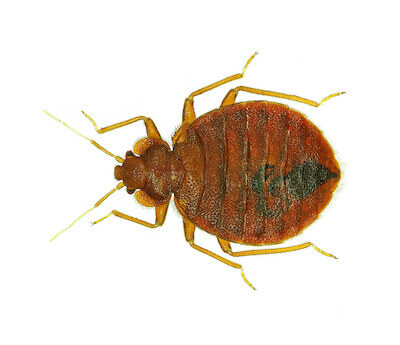WHAT DO BED BUGS LOOK LIKE

Adult bed bugs are visible to the human eye and can be detected by sight, especially within mattress seams and box springs. Bed bug nymphs can be harder to identify, as they are smaller in size and paler in color. Bed bugs are an oval shape and only grow to about 3/16th of an inch in length. Prior to feeding, they are brown and flat. After feeding, bed bugs become redder in color, swollen, and elongated. Bed bugs have 6 legs and 2 antennae. Despite having reduced “wing pads,” bed bugs do not have wings and cannot fly.
Most bedbug bites are painless at first, but later turn into itchy welts. Bed bugs can multiply very quickly and spread to other rooms in your home, which is why you need bed bug treatment at your home or business as soon as you see one. Bed bugs are active mainly at night and usually bite people while they’re sleeping. They feed by piercing the skin and withdrawing blood through an elongated beak. The bugs feed from three to 10 minutes to become engorged and then crawl away unnoticed.
Bed bugs are most easily identified by small reddish-brown fecal spots on mattresses, upholstery, or walls. If these spots are found, it can indicate an infestation. Bites on the arms and legs are also a tell-tale sign of bed bugs. While these bites can be small, if they swell and become itchy, they are noticeable. It can take two to three days for bed bug bites to appear, allowing the infestation to grow.
Infestations can also be identified by sightings of bed bug molt skins, their eggs, empty eggshells, or the bugs themselves. All these things are quite small, but still visible to the human eye and certainly easier to spot by the trained eye. Both bed bug’s molted skins and their eggshells appear pale white after molting or emerging from the eggshell. Bites alone do not indicate an infestation without other bed bug evidence. But the sad truth is there’s almost never just one bed bug.
Most bedbug bites are painless at first, but later turn into itchy welts. Bed bugs can multiply very quickly and spread to other rooms in your home, which is why you need bed bug treatment at your home or business as soon as you see one. Bed bugs are active mainly at night and usually bite people while they’re sleeping. They feed by piercing the skin and withdrawing blood through an elongated beak. The bugs feed from three to 10 minutes to become engorged and then crawl away unnoticed.
Bed bugs are most easily identified by small reddish-brown fecal spots on mattresses, upholstery, or walls. If these spots are found, it can indicate an infestation. Bites on the arms and legs are also a tell-tale sign of bed bugs. While these bites can be small, if they swell and become itchy, they are noticeable. It can take two to three days for bed bug bites to appear, allowing the infestation to grow.
Infestations can also be identified by sightings of bed bug molt skins, their eggs, empty eggshells, or the bugs themselves. All these things are quite small, but still visible to the human eye and certainly easier to spot by the trained eye. Both bed bug’s molted skins and their eggshells appear pale white after molting or emerging from the eggshell. Bites alone do not indicate an infestation without other bed bug evidence. But the sad truth is there’s almost never just one bed bug.